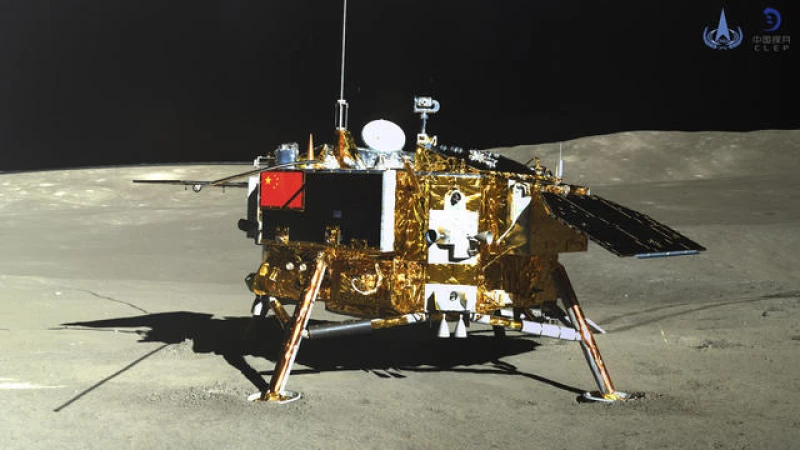China on Friday launched a lunar probe to land on the far side of the moon in a first-of-its-kind mission to return with samples that could provide insights into differences between the less-explored region and the better-known near side.
It is the latest advance in China's increasingly sophisticated space exploration program, which is now competing with the U.S., still the leader in space.
Free from exposure to Earth and other interference, the moon's somewhat mysterious far side is ideal for radio astronomy and other scientific work. Because the far side never faces Earth, a relay satellite is needed to maintain communications.
China also has a three-member crew on its own orbiting space station and aims to put astronauts on the moon by 2030. Three Chinese lunar probe missions are planned over the next four years.
The rocket carrying the Chang'e-6 lunar probe - named after the Chinese mythical moon goddess - lifted off Friday at 5:27 p.m. as planned from the Wenchang launch center on the island province of Hainan.
Huge numbers of people crowded Hainan's beaches to view the launch, which comes in the middle of China's five-day May Day holiday.
Upon completing its orbit around the moon to decrease speed, the lander will detach from the spacecraft and promptly begin collecting samples. It will later rendezvous with the returner for the journey back to Earth. The entire mission is expected to span 53 days.
In 2020, China successfully retrieved samples from the moon's near side, marking the first such mission since the conclusion of the U.S. Apollo program in the 1970s. Analysis of the samples revealed the presence of water in small beads embedded in lunar soil.
Additionally, over the past week, three Chinese astronauts returned to Earth following a six-month mission aboard the country's orbiting space station, coinciding with the arrival of the new crew. The Shenzhou 18 mission to rotate the crew marked China's seventh manned journey to its space station, and the fifth since continuous staffing commenced in June 2022.
China constructed its own space station after being excluded from the International Space Station, primarily due to U.S. concerns regarding the Chinese military's complete oversight of the space program amid escalating technological competition between the two geopolitical adversaries. U.S. legislation prohibits nearly all collaboration between the U.S. and Chinese space programs without explicit congressional authorization.
China's ambitious space initiative aims to land astronauts on the moon by 2030, retrieve samples from Mars around the same timeframe, and launch three lunar probe missions within the next four years. The upcoming mission is slated for 2027.
In the future, there are plans to establish a permanent crewed base on the lunar surface, although these plans are still in the early stages.
Back in 2003, China achieved its first crewed space mission, becoming the third nation, after the former Soviet Union and the U.S., to independently send a person into space.
The Tiangong space station, consisting of three modules, was launched in 2021 and completed within 18 months. Although smaller than the ISS, this space station can host up to six astronauts simultaneously and is primarily focused on scientific research. Apart from conducting experiments, the crew will also set up equipment for protecting against space debris, carry out payload experiments, and even deliver science lessons to students on Earth.
China has expressed its intentions to eventually allow foreign astronauts and space tourists access to its space station. As the ISS approaches the end of its operational life, China could potentially become the sole country or entity to maintain a crewed station in orbit.
Despite China's advancements, the U.S. space program is believed to maintain a significant advantage in terms of funding, supply chains, and overall capabilities.
The Race to the Moon: A New Era of Space Exploration
In a bold move, the U.S. has set its sights on sending a crew back to the lunar surface by the end of 2025. This renewed commitment to crewed missions is being supported by private sector giants like SpaceX and Blue Origin. The plan is to land on the moon's south pole, where scientists believe there are permanently shadowed craters filled with frozen water.
As part of this ambitious goal, NASA and its partners are making plans to retire the International Space Station (ISS) in 2030. The ISS will be remotely guided to a destructive re-entry over the south Pacific Ocean, far from any shipping lanes or populated areas. This decision will leave China's Tiangong as the sole government-operated space station in low-Earth orbit.
Meanwhile, China is gearing up to launch its own taikonauts to the moon starting in 2030, sparking what NASA Administrator Bill Nelson has dubbed as a new superpower space race.
"It is a fact: We're in a space race," Nelson emphasized in an interview. "We must be vigilant to ensure that they do not establish a presence on the moon under the guise of scientific research. There is a possibility that they could claim territory and demand others to stay away."







